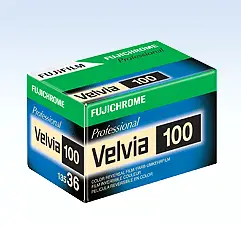Here we are again with more field notes. This time, we’re looking at Fuji Velvia 100, which was reviewed right here.
Fuji Velvia 100 (RVP 100) specifications
 |
|
| Name | Velvia 100 |
| Vendor | Fuji |
| Type | Slide (Color Reversal) |
| Format | 35mm, 120, Sheet |
| Speed (ISO) | 100 |
| Exposure latitude | –-1/2 to +1 stops |
| Push processing | 1 stop |
| Cross processing | Blues and reds |
What’s it really like? (the quick version)
It can be a bit picky to shoot but as long as you control your exposure and bracket your shots when in difficult lighting conditions, you’ll be fine. It’s a rich, beautiful film, which gives your images tons of depth, lovely tones and exudes a feeling of professionalism and experience. In that respect, it can’t be faulted.
Personally, I’ve learned to shoot this film at ISO 125 for the best results but your location, the light and time of day may lead you to shoot otherwise. If you’re shooting this film for the first time, bracket your exposures at ISO 80, 100 and 125 and see what you get.
It might not handle all skin tones with as much ease as Velvia 100F but if you need that extra stop over Velvia 50 and demand a similar look, then there’s no real competition (yet).
Further reading
You can read much more about this film in my main review.
Share your knowledge, story or project
The transfer of knowledge across the film photography community is the heart of EMULSIVE. You can add your support by contributing your thoughts, work, experiences and ideas to inspire the hundreds of thousands of people who read these pages each month. Check out the submission guide here.
If you like what you’re reading you can also help this passion project by heading over to the EMULSIVE Patreon page and contributing as little as a dollar a month. There’s also print and apparel over at Society 6, currently showcasing over two dozen t-shirt designs and over a dozen unique photographs available for purchase.












It should be mentioned that RVP100 is a wonderful pinhole emulsion, with excellent Reciprocity Failure, similar to Acros 100 (alas, both are doomed by the Instax monster). There are explicit RF curves on the web for RVP100, but you can get the gist of it here:
http://www.fujifilm.com/products/professional_films/pdf/velvia_100_datasheet.pdf
It’s also easier to scan than velvia 50